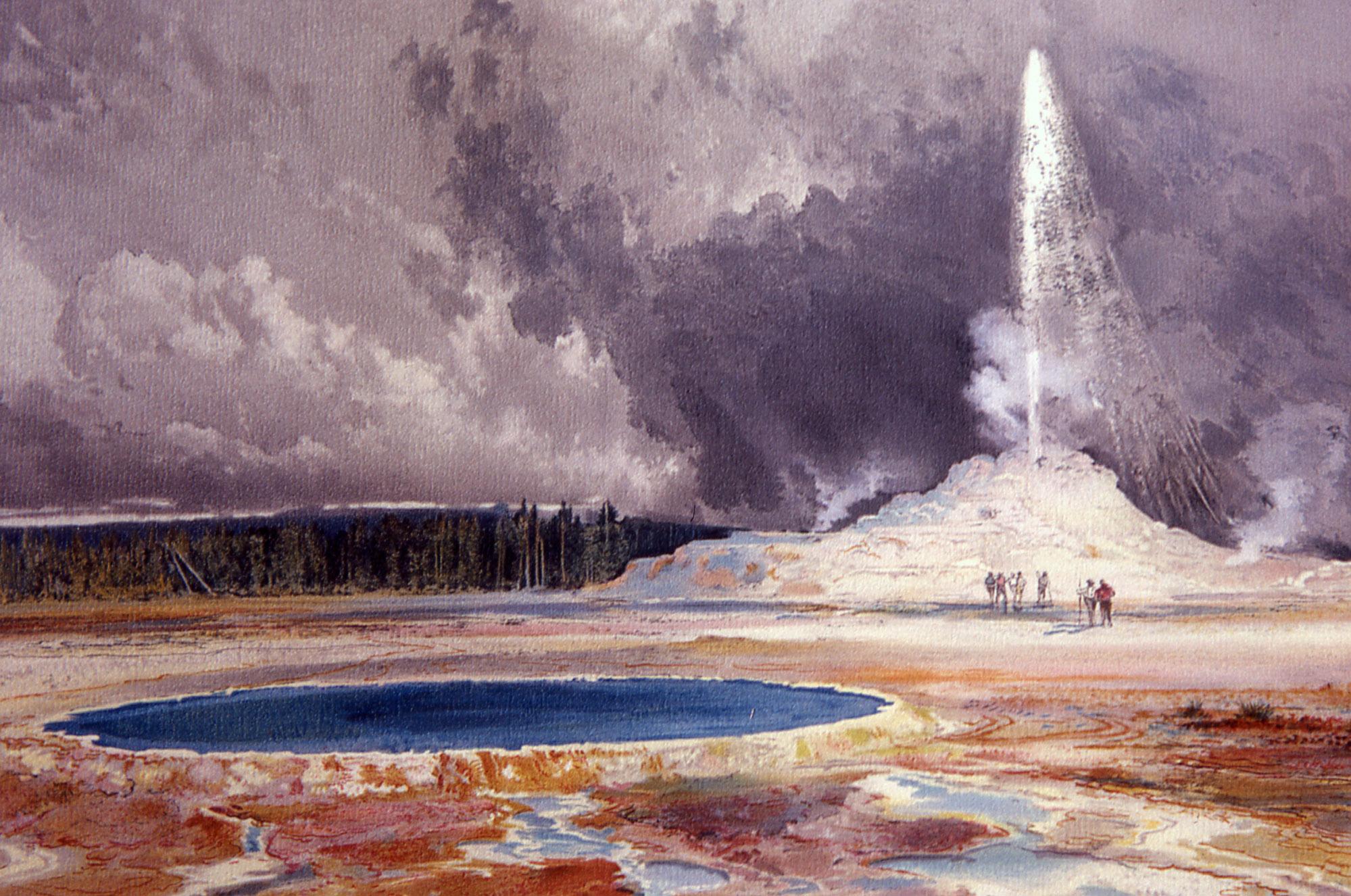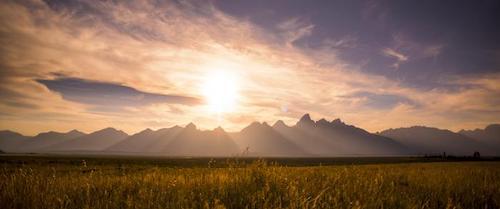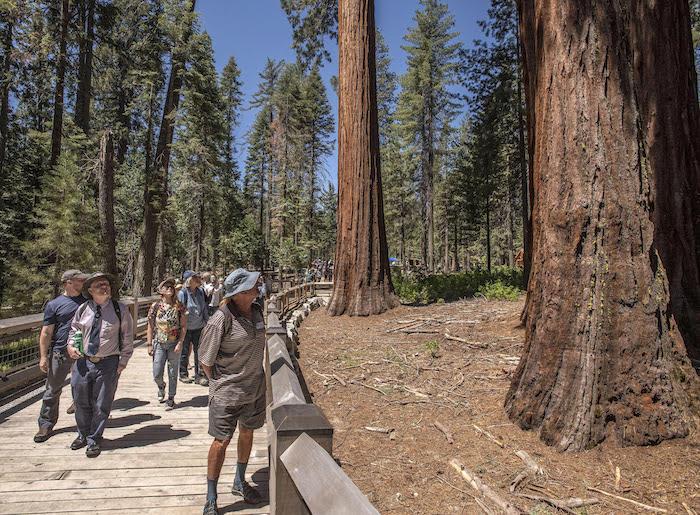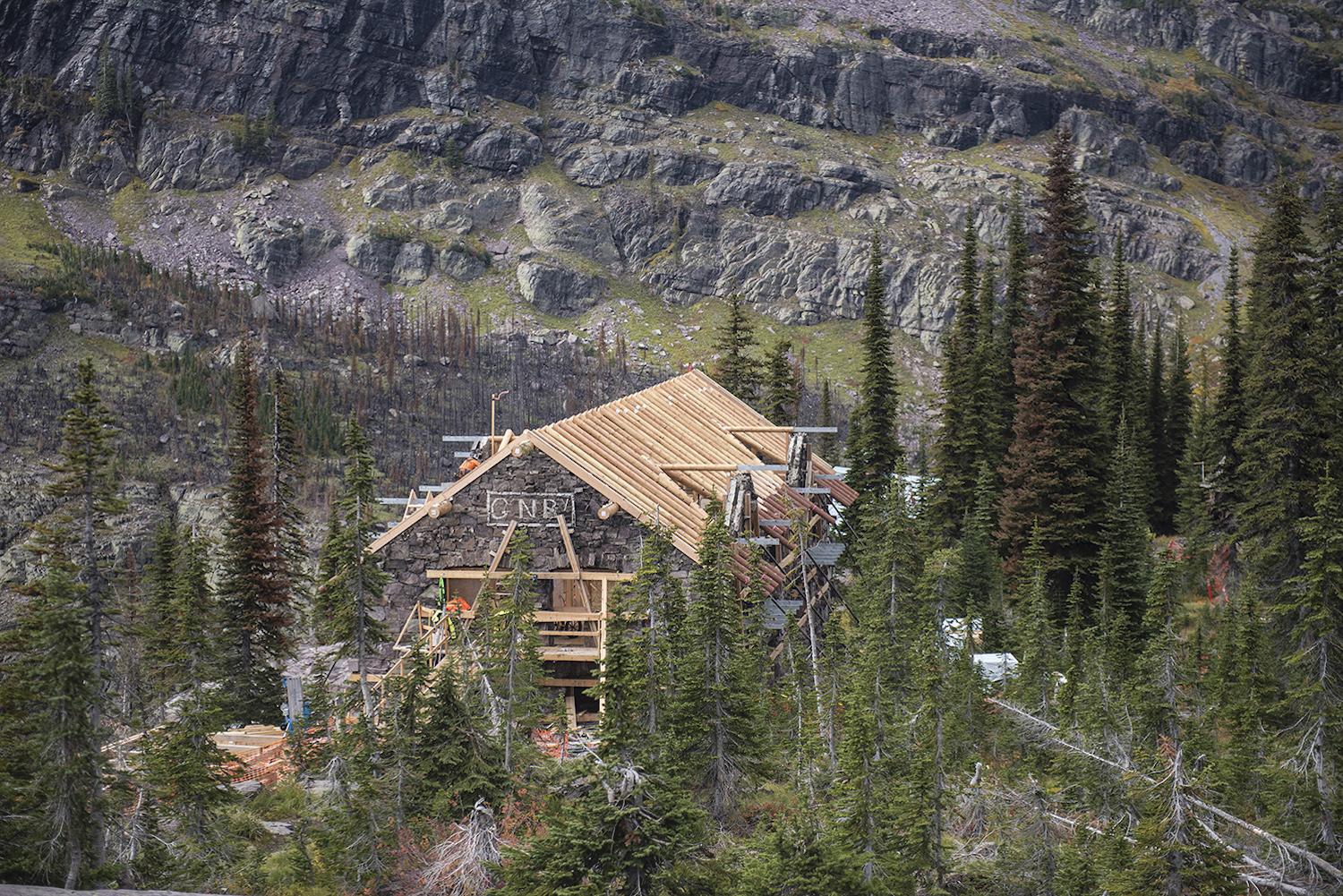National Parks' Dependency On Friends Groups Can Be Risky

Philanthropy is critical to national parks, but it carries risks/LOC, Thomas Moran painting of Castle Geyser
It's been more than a half-century since the Beatles let the world know they get by with a little help from their friends. Certainly, that's true for national parks from coast to coast, which have been able to accomplish much with philanthropic dollars raised by friends groups. But what happens if those dollars vanish?
As the National Park Service budget has struggled in recent decades to meet the National Park System's needs, friends groups have been asked to step up. And not just with small dollar amounts. The Grand Teton National Park Foundation, for example, raised more than $14 million to help its namesake park rehabilitate the Jenny Lake area, while the Yosemite Conservancy contributed $20 million towards the restoration of the Mariposa Grove in Yosemite National Park.
So important has been the money flowing from friends groups to parks that former Interior Secretary Sally Jewel once described that support as the parks' "margin of survival."
As National Parks Traveler pointed out two years ago as part of its multi-part series on the huge maintenance backlog across the park system, reliance by parks on philanthropic sources corralled by park friends groups has twisted the long-held view that these nonprofit organizations provide a “margin of excellence” for the parks they support. These days, more and more park superintendents are turning to friends groups for dollars, millions of dollars in many cases, to address operational needs, such as trail and campground work and historic building restoration.
Though an impressive display of support, there can be an over-reliance on such funding, as Yellowstone National Park Superintendent Cam Sholly found out earlier this year when Yellowstone Forever ran into dire fiscal straits and its flow of philanthropic dollars to the park turned into a trickle. Dollars that supported such programs as Yellowstone's Wolf Project, and its Native Fish Conservation Program pretty much vanished.
The nonprofit organization's financial and organizational struggles, which are continuing amid a search for a new CEO, also led to the closure this year of the Yellowstone Institute, a popular program with offerings ranging from citizen science projects to art in the park.
The problem from Sholly's vantage point is that the park had come to rely too much on Yellowstone Forever's annual grants, which amounted to millions of dollars, to run programs touching on wildlife research and management, visitor experience, youth education, and sustainability.
"This is a model that's developed over time where they fund employees that are YF employees, funded out of philanthrophy, out of usually restricted philanthrophy, and then those employees are embedded with our teams," explained the superintendent in early June. "One of the biggest irritations I had here in the last couple of months was we have YF employees assigned with our teams and they got furloughed" when Yellowstone Forever reduced its workforce in an effort to get its budget out of the red.
While special donations arrived to restore those positions, said Sholly, the scenario underscored the problem of relying on philanthropic dollars for key programs in the park.
Yellowstone "is allowing too many critical programs to rely on philanthropy in order to succeed," he went on. "What I mean by that is if the wolf program gets $450,000 a year from donors through YF, we've got to ensure that the wolf program has enough federal funding in place. We always want the philanthropy and can use it, and so many things get done. ... But what I don't want to have happen is if philanthropy wanes or goes down substantially, that suddenly we're putting critical programs at risk, like native fish or wolves, that kind of thing.
"We shouldn't have those programs in a vulnerable position to other people's generosity," said Sholly.

The National Park Foundation and Grand Teton National Park Foundation combined efforts to acquire Antelope Flats for Grand Teton National Park/Ryan Sheets
The National Park Foundation, which raises hundreds of millions of philanthropic dollars for the parks, can at times come to the rescue when local efforts struggle, or partner on projects deemed valuable for parks.
“We have a dynamic relationship with both NPS and our local partners and frequently work with each other to fund specific projects. Our purchase of Antelope Flats in Grand Teton is a great example of that," said Will Shafroth, the foundation's president and CEO. "Together with the Grand Teton National Park Foundation, we raised $23 million and the National Park Service contributed $23 million. As I’ve said many times before, supporting the parks is a team sport; in this case it took the three entities to get it done.
"So, it is not unusual at all for us to work with a local partner to help fund a priority of the Park Service," he added. "In the case of the conservation of Yellowstone cutthroat trout, NPF is already working with Yellowstone Forever and the Park Service to advance that project. Where a local group may be struggling to raise critical revenues and the Park Service holds as a priority a certain program or project, NPF will endeavor to help where it can.”
Certainly, the situation at Yellowstone Forever is extreme, but it underscores the importance of both ongoing financial scrutiny and planning for the worst-case scenario by the boards of nonprofit organizations.
"Our partnership philanthropy would not end unexpectedly, leaving projects in limbo or incomplete," Leslie Mattson, president and CEO of the Grand Teton National Park Foundation, replied when asked what would happen if there was a significant drop in philanthropic giving to her organization.
"When developing our annual work plan with Grand Teton, which is done in very close coordination with our park partner, we either have the resources on-hand or have a high degree of confidence in already identified sources of funds, and this knowledge gives our foundation and Grand Teton the comfort of knowing that we will indeed be able to fulfill commitments," she said. "Generally speaking, fundraising in arrears for our park projects is not in our normal operating procedure.
"Further, our annual work plans and funding commitments are guided by a long-range plan that includes multi-year revenue goals," she said. "This allows us to plan the pace and scale of our project work and match that with revenue goals in a way that increases our success."
Park superintendents also have to be responsive to changing circumstances.
While the Glacier National Park Conservancy has run a "very lean operation" and kept its liabilities low, Glacier Superintendent Jeff Mow said that as a result of the coronavirus pandemic, “We’ve sort of held off on a lot of things that could wait a year."
"We don’t want to start with zero dollars in philanthropy," he explained. "So we’ve been working with them to ensure that there’s kind of a corpus there next spring, for next year’s spending. We have sort of pulled the reins in a little bit and looked carefully at what could wait until next year.”

The restoration of the Mariposa Grove in Yosemite National Park was made possible by the Yosemite Conservancy/NPS
Yosemite Conservancy President and CEO Frank Dean has seen the issue from both sides, as he was a Park Service employee for nearly four decades, with many years logged as a superintendent. He appreciates the role of friends groups providing a margin of excellence, and believes Congress ideally would be providing the needed operational funds for parks.
"But we've been doing this since the late '80s on the philanthropic side," he said when discussing the roughly 60 seasonal positions his organization supports each year. "It's sort of the margin of excellence."
For Sholly, though, relying too much on philanthropic revenue streams can be problematic.
"I think we've gotten too overly reliant on funding some of those critical programs with philanthropy," the Yellowstone superintendent said. "It has been generally reliable over the years, and I'm not saying that we don't continue to use it to support those functions, and a lot of people donate specifically for those things.
"But the core of those programs shouldn't be predicated on it."

Endowment funds help Friends of Acadia maintain the carriage roads in Acadia National Park/Rebecca Latson file
What Role Should Philanthropic Groups Fill For National Parks?
What is transpiring with Yellowstone Forever, and how the coronavirus pandemic has adversely impacted philanthropic donations and retail revenues for nonprofit friends organizations, raise questions that play a role in the long-term programmatic health of the parks.
"Your questions get at the risks to NPS and park visitors of relying too heavily on private philanthropy for core park activities," said Leslie Mattson of the Grand Teton National Park Foundation. "These are good questions to ask, and we believe that most, if not all, park philanthropic partners actively think about this in relation to supporting their park.
"When considering our partnership projects in Grand Teton, we focus our philanthropy in ways that add value and that do not serve to offset the federal responsibility to provide adequate funds for its management and operations," she added. "We focus on opportunities that would not otherwise be possible to accomplish without philanthropy and/or to strive to achieve a higher level of quality and raise the level of excellence beyond what the park could do without the philanthropic support."
While Mattson noted that there long has been the "important distinction that park philanthropy should provide 'the margin of excellence in parks, and not the margin of survival' (attributed to Sally Jewell), or the 'bright line' between public and private support for national parks (attributed to David Rockefeller)," that is easier said than accomplished in these days of insufficent park funding.
"In an ideal world, philanthropy is a good thing, right, you don't want to rely on it for your core programs," said Yosemite Conservancy President and CEO Frank Dean.
But some park programs, such as interpretive programs, don't benefit from park fee collections, "so that's where we can help with their seasonal staff. ... I can see how there's a hesitation to rely on that. Ideally, it's great to have everything you need in the (park operations budget) account from Washington, but I think there's another case that can be made, too, that philanthropy can do things.
"I'm a 39-year veteran of the Park Service, I think partners can be more nimble, and the money is more fluid," Dean pointed out. "I think it can make a difference. You don't want to rely on it for your core things like law enforcement and maintenance, but those are inherently government functions anyway."
Not to be overlooked is that there are numerous friends organizations across the country that support national parks, and the coronavirus pandemic has impacted more than a few.
"There are a lot of groups struggling right now, but I think we'll all bounce back, most of us,' said Dean. "Some of the bigger ones are trying to figure out how we can support the other ones as well in this moment."

The Glacier National Park Conservancy helped the Sperry Chalet rise like a phoenix from the ashes/Glacier Conservancy
Friends Of Acadia
At Friends of Acadia, which provided more than $2.2 million in support to Acadia National Park last year, the nonprofit's board and finance committee have grown reserves and endowments to ensure that even in a challenging year they would not have to scale back support to the park, said Earl Brechlin, FOA's communications director.
Overall, the organization has roughly $50 million in endowments that it uses to provide support to the park, he said. Programs funded through those endowments revolve four philosophical "pillars": The Acadia Experience, Tomorrow's Stewards, Wild Acadia and Trails and Carriage Roads.
Other projects are handled on a specific basis, such as FOA's fundraising to help the park acquire the iconic Bass Harbor Light. But such assistance can't be guaranteed.
"Like any organization, the (coronavirus) pandemic prompted us to look at our budget in light of what may not be needed, what may not manifest in its entirety, or what can't happen for a variety of external reasons," said Brechlin.
"It's important when looking at the level of support any group provides to understand that some years could have large fluctuations depending on whether or not monies raised for specific, one-off projects, had been spent," he said.
"For instance, if you had a campaign to raise $1 million for a new visitor center, the year you expended all or part of that money would show a higher level of spending than the year before or after. Lower amount in subsequent years wouldn't mean a reduction in support, rather, a return to more normal levels."
Glacier National Park Conservancy
In Montana the Glacier National Park Conservancy has played a key role for Glacier National Park, coming to the rescue when the Sperry Chalet burned to the ground on top of regularly funding a number of key programs in the park.
"Our donors have made it possible for us to provide the park with more than $2 million in grants to support over 50 educational, preservation, and research projects in each of the past three years," said Executive Director Doug Mitchell. "Many of those grants support positions, or parts of positions in various areas of expertise across the park that protect the resource and provide critical services to the public."
Careful budgeting and monitoring of incoming donations has enabled the Conservacy to fully fund 76 projects in the park this year, "and we are working collaboratively with our park partners to set shared expectations and priorities for 2021 and beyond," said Mitchell. "This unprecedented challenge is going to call upon all of us in this community to innovate, adapt, and communicate effectively in order to successfully navigate these uncharted waters. We're fortunate here in Glacier Park and at the Glacier Conservancy to be well situated to do just that."
Mitchell and his team has met with Glacier staff to analyze what is possible under current funding scenarios. Part of that analysis has involved "how the park might innovate/adapt certain needs/budgets, and how we might do the same."
"Given park staffing issues in 2020 (like many parks, Glacier will operate with fewer seasonal employees this year), there may be some funded programs that roll forward to 2021, and that will give us a running start on already funded projects that will help flatten any curve that may result from a reduction in revenue," he said.
Yosemite Conservancy
Frank Dean, president and CEO of the Yosemite Conservancy, fully understands the needs of a park such as Yosemite, and the constraints on a nonprofit organization such as the Yosemite Conservancy.
"We're not really dependent on retail and educational programming for income as much as some of the other nonprofits in parks, so we're primarily philanthropic, raising money that way," he said. "So we just have a really loyal donor base, and the way we base our grants each year, it's based on the previous year's income. So we have sort of a formula that we use, based on the previous three quarters of the year, by the time we meet in the fall (to discuss the coming year's grants), we pretty much have the money in the bank as far as what we're going to commit to in the park in the new year."
Additionally, Yosemite Conservancy in recent years has gotten into the habit of conducting "stress tests" by envisioning scenarios where giving would drop off by various percentages, such as a 5 percent or 10 percent decline, and how might that impact its programs, said Dean.
"When we circled back to the park as things became more clear in the spring (regarding the pandemic), we said, 'What can you pull off if you're going to have less staff that you're hiring, are you going to be able to implement all of your grants? The money's there, but can you do it?'" he said.
The Conservancy was ready to give the park more than $8 million for programs and support, said Dean, but in the end the park returned money for seasonal positions it didn't hire because of a lack of housing under Covid-19 guidelines.
"In the end, they decided to rescind $2.4 million back to us," said Dean. "Obviously, the money is going to be available for them as things calm down."
Grand Teton National Park Foundation
The board of the Grand Teton National Park Foundation holds tight to its belief that it exists to provide Grand Teton with a margin of excellence, not to support routine operations.
That has been demonstrated in the foundation's work not just at Jenny Lake with the multi-million-dollar rehabilitation project, but in working with the National Park Foundation to acquire the Antelope Flats, to help orchestrate the transfer of the Moulton Ranch Cabins to the park, and this year's launch of a multi-year, multi-million-dollar project to improve access to the Snake River through the park.
As with Friends of Acadia and its work with Acadia, the Grand Teton National Park Foundation's year-to-year support to Grand Teton can vary largely depending on what projects are approved.
"Total annual support to Grand Teton from our foundation has varied between $3 million and $15 million. In certain instances, partnership project work requires project funding for personnel as a way to accomplish a project or execute a program," said foundation President and CEO Leslie Mattson. "We do not fund full-time park staff because both the park and the foundation appreciate the potential negative consequences to the park of relying on philanthropy to fund park employees."
Additionally, the foundation's board believes the Park Service should be a financial partner as often as possible.
"This concept of both the park and foundation having 'skin in the game' is meaningful to our board and our donors, and I think it has the added benefit of minimizing financial risk to the park on any one project, in the unlikely event that philanthropic funding becomes unavailable," said Mattson. "In this way, the projects and programs can still be accomplished without philanthropy, but in a much scaled down and minimalistic fashion."

Add comment